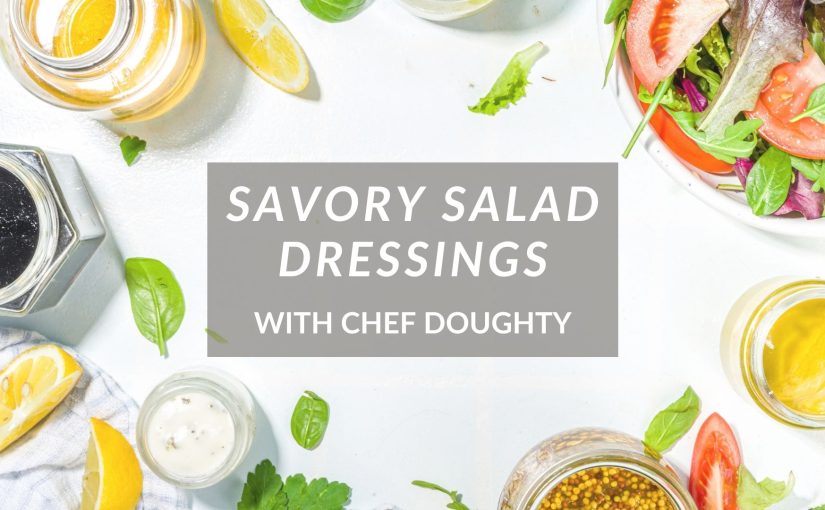Making salad dressings is something every cook should embrace with gusto! Homemade salad dressing have such a fresh and authentic taste. They are a great way to develop a creative, culinary mind and they can be customized easily to match the salad you are making.
A dressing comes together easiest when it is made in the blender. Ingredients are thrown together, whirred until emulsified and taken to the table. Dressings last forever in the fridge so don’t hesitate to make a larger recipe which can make reappearances for several weeks and even months.
When creating your own dressing, write down the ingredients of your first attempt and then make notes as to what you wish to adjust. And here’s some great news…if you make a dressing that doesn’t meet your expectations, simply use it as a marinade for meats or grilling vegetables. You can’t lose!
VINAIGRETTES
The base of a dressing is oil and acid. The oil can be olive oil, a vegetable oil, peanut oil, or any oil with the exception of straight sesame oil., which is too strong by itself. The acid can be any vinegar and/or the juices of any citrus.
The Ratio: Generally speaking, the ratio of oil to acid starts at 2:1 for astrong dressing, 3:1 for a moderately acidic dressing or 4:1 for a milder tone. This translates, for example, to 1 cup oil to ½ cup acid (2:1 ratio) OR 3 cups oil to 1 cup acid (3:1 ratio) OR 4 cups oil to 1 cup acid (4:1 ratio)
Acids and their strength: Vinegars vary in potency. Here are four listed from strongest to weakest: apple cider, red or white wine vinegar, balsamic, and rice vinegar. Lemon juice would be a strong acid, whereas grapefruit juice not so much and orange juice, hardly acidic at all. With those strengths in mind you can best determine what your ratio of oil to vinegar should be. There is no need to purchase special flavored vinegars. For example, is a recipe calls for raspberry vinegar, then just whir a few fresh or frozen raspberries with your dressing – OR raspberry jam OR frozen raspberry juice concentrate, all of which will provide the essence of raspberries.
CHOOSING AN OIL
Having on hand one type of vegetable oil and one type of olive oil will enable you to create any and all dressings. If a recipe calls for walnut oil, simply use the vegetable oil but whir a few walnuts in the dressing. Need a chili oil? Simply add a few red pepper flakes to the blender cup. The only oil to be used with caution is sesame oil. Toasted sesame oil is a very strong flavor and if you are after some of that wonderful essence, use primarily vegetable oil with only a small portion of sesame oil. Another oil opportunity: mayonnaise is 95% oil so do not hesitate to interchange it with the oil for that added creaminess.
Essential ingredients for a great dressing: a full flavored dressing should consist of oil and acid, salt, pepper, fresh garlic, and a sweetener.
- The saltiness could come in the form of salt, Worcestershire sauce, soy sauce, tamari, miso or fish sauce, if making a Thai flavored dressing.
- The pepper can be regular black pepper, white pepper, cayenne, red pepper flakes, etc.
- Garlic is the magical ingredient that tempers the whole thing. You do not need large amounts of garlic to be effective, but it does need to be fresh and minced superfine to permeate throughout. This is where a garlic press would be useful.
- The sweetener can be white sugar, brown sugar, honey, molasses, maple syrup, jams, and jellies and flavored syrups.
Additional ingredients to customize a dressing: This list includes the rinds of any and all citrus, berries, frozen juice concentrates, nuts, peanut butter, herbs and spices, mustards, ketchup, sun-dried tomatoes, salsa, Worcestershire sauce, and probably many, many more.
BASIL VINAIGRETTE
The following recipe is the recipe for the basil dressing which was featured at the restaurant. It is a more potent dressing because the ratio of oil to vinegar is 2:1. It serves as a great dressing and also a marinade for vegetables, chicken and all kinds of meats. The shelf life is indefinite.
½ cup unseasoned rice vinegar
½ cup olive oil
½ cup vegetable oil
2 tablespoons dried basil (or about 1 cup coarsely chopped fresh basil)
1 tablespoon sugar
1 teaspoon salt
1 teaspoon freshly ground black pepper
4 cloves garlic, minced
Directions: Combine all ingredients in a blender and whir for about one minute or until everything is well emulsified.
Hungry for more? Check out Chef doughty’s book; The Chef Within Dinner Edition. Find more information and order your copy online here:
https://www.thechefwithinbook.com/bookstore/dinner-book
Meet Chef Doughty

We know her as part owner of Silvercreek Realty Group and the smiling face behind the brokerage accounting department, but did you know that Joyce Doughty has an affinity for culinary arts?
Chef Doughty is a successful food writer and restaurateur who hosted the nationally syndicated daily Public Radio food program “Food for Thought” for 17 years and was also host of the local ABC affiliate morning program “In the Kitchen” highlighting practical recipes and techniques for the kitchen. Recipient of the James Beard Foundation Top Three Chefs in Idaho Award and owner and chef of Idaho’s critically acclaimed Doughty’s Bistro. Chef Doughty was trained at Le Cordon Bleu and received her executive chef certification from the American Culinary Foundation.
